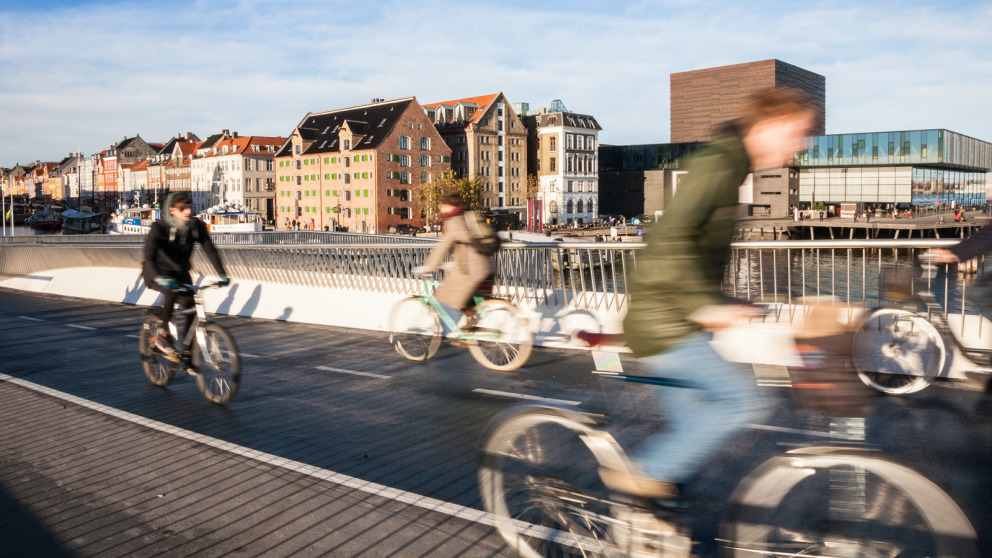Safety First: Lessons Learned From Copenhagen Could Accelerate the Mobility Transition
18.03.2021
Proponents of a “mobility transition” would do well to take lessons from such successful role models as Copenhagen, one of the most bicycle-friendly cities in the world. Which discourses fuelled Copenhagen’s transformation into the city of cycles it is today? IASS researcher Theresa Kallenbach studied the coverage on cycle traffic in Danish daily newspapers and discovered that road safety took centre-stage in a debate from which environmental concerns were all but absent.

Following decades of urban planning that prioritized motor vehicles, tens of thousands of people took to the streets in Copenhagen in the late 1970s and early 1980s to demonstrate for the development of protected bike lanes (also known as “cycle tracks”) – their campaigns met with success. Today, cycle path infrastructure is prized by the people of Copenhagen: according to a 2018 survey, 84 per cent of the Danish capital’s inhabitants consider it a good city for cyclists, 77 per cent feel safe when cycling; 49 per cent journey to work, school, or another place of learning by bicycle. Overall, 28 percent of all trips in the city are made by bicycle. Previously, the number of cyclists in the city had dropped significantly throughout the car boom of the 1950s and 60s and as a result of car-centric transport policies.
Just how did Copenhagen rebuild its identity as a bicycle-friendly city and what lessons can we draw from this for Germany today? In a new IASS Discussion Paper, Theresa Kallenbach describes the findings of her analysis of the narratives covered in the five largest daily newspapers (by circulation) in Denmark from 1977, 1980 and 1983. Kallenbach identifies four key insights from Copenhagen’s mobility revolution:
1. Narratives focussed on road safety put protected bike lanes on the transportation policy agenda
In Denmark, the discourse was shaped substantially by reports of road accidents and news items about road safety. On the one hand, this focus merely reflects the poor state of road safety in the 1970s; on the other hand, it is also representative of the media’s affinity for topics with a high news value. “Road safety is a go-to topic for the media: it’s local, it’s of immediate relevance to readers, and it’s potentially a matter of life and death. This makes road safety a promising issue in contemporary discourse and it is often deployed as an argument for the development of dedicated cycling infrastructure separated from motorized transportation,” explains Kallenbach.
2. We can protect the environment without talking about it
Previous studies have shown that narratives focussed on environmental concerns and climate change often struggle to gain acceptance in public debates around mobility. According to Kallenbach, this suggests that demands to improve the sustainability of transportation must be linked to other goals if they are to be heard amid the hustle and bustle of contemporary political debate. Copenhagen shows that this strategy can work: there, environmental concerns did not play a role in the transport policy debate 40 years ago. “The protected cycle lanes created since then don’t just provide protection against accidents, they encourage people to choose the greener climate-friendly mobility option of cycling and provide the necessary infrastructure. This shows that we can actually achieve environmental goals without even talking about them,” explains Kallenbach.
3. Language matters – Using the term “vulnerable road user” can promote a focus on design solutions
According to Kallenbach, demands for safer cycling infrastructure are frequently countered in current debates with blanket accusations of reckless behaviour by cyclists. According to these claims, cyclists consistently run red lights, ride on the footpath, and seldom miss an opportunity to break the rules. The same patterns can be found in the Danish debates of the 1970s and 1980s. Two aspects are important to note, says Kallenbach: “Shifting the focus of the debate from built infrastructure to individual behaviour is problematic because it depoliticizes the debate and suggests that everything would be fine if road users simply followed the rules. This distracts from the deficiencies in transport infrastructure that often encourage or necessitate ‘misbehaviour’ – such as when cyclists ride on the footpath because they feel unsafe in heavy traffic on a narrow road.”
Attributing such ‘misbehaviour’ to cyclists as a whole, rather than to individuals, can advance the debate: “If it is true that cyclists are ‘always’ a threat to pedestrians, then there is an obvious need to create protected cycle lanes. And if motorists cannot help but drive too close to cyclists, then road construction solutions are needed to separate these two groups.” The use of terms such as “vulnerable road users” or – “stronger” and “weaker” road users in the Danish case – can also highlight the different risks faced by different groups of road users, underscoring the need to separate these groups so that they can reach their destinations safely.
4. View antagonists as potential allies
Animosity towards motorists did not play a significant role in Danish reporting. Although motorized vehicles were described as a constant source of danger for cyclists, they figure as unpredictable, inanimate objects that could be tamed by building appropriate infrastructure. Instead, the opponents in these narratives were local authorities that ignored calls for the development of protected cycle lanes, for example, or railway companies that refused to transport passengers’ bicycles. But these narratives did not demonize them as inherently “evil”: it was always within their remit to fulfil the demands made of them and, by doing so, to slip out of the role of antagonist and into that of an ally and helper without losing face.
Kallenbach, T. (2021): Von Kopenhagen lernen: Erfolgreiche Narrative für eine nachhaltige urbane Mobilität; Ergebnisse einer repräsentativen Analyse des dänischen Zeitungsdiskurses der Jahre 1977 bis 1983. - IASS Discussion Paper, March 2021.
Contact
